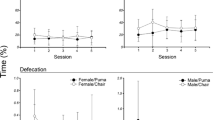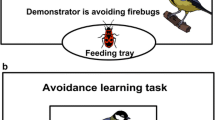Abstract
Animals that are isolated from their natural predators may lose the ability to express antipredator behavior. The aim of this study was to test whether it would be possible to train captive-bred North American bullfrogs (Rana catesbeiana) to avoid a model avian predator and to measure their behavioral responses to this predator. We used 18 animals divided into two groups, trained (N = 6) and control (N = 12); these individuals were from a line that has been bred in captivity for at least 20 generations without predator contact. The trained group was exposed, individually, to 20 sequential antipredator training sessions, during which the presence of a model avian predator was paired with an aversive stimulus. The control group was exposed, individually, once only to the same model avian predator, but without the association of the aversive stimulus. Both groups were observed for 10 min after the presentation of the avian predator, during which their behavior was recorded using instantaneous recording of behavior. The results showed that, after only two training sessions, the trained bullfrogs started to express proper antipredator behavior: diving to the bottom of the tank, lying still, and eventually, learning to cover themselves in substrate (mud). However, continued training sessions provoked a varied response to antipredator training, which was undesirable as the effectiveness of their antipredator response varied. This study has shown that captive-bred bullfrogs were capable of learning antipredator behavior, despite having been bred for many generations in captivity with no predator contact.


Similar content being viewed by others
References
Azevedo CS, Young RJ (2006a) Behavioral responses of captive-born greater rheas Rhea americana Linnaeus (Rheiformes, Rheidae) submitted to antipredator training. Rev Brasil Zool 23:186–193
Azevedo CS, Young RJ (2006b) Do captive-born greater rheas Rhea americana Linnaeus (Rheiformes, Rheidae) remember antipredator training? Rev Brasil Zool 23:194–201
Azevedo CS, Young RJ (2006c) Shyness and boldness in greater rheas Rhea americana Linnaeus (Rheiformes, Rheidae): the effects of antipredator training on the personality of the birds. Rev Brasil Zool 23:202–210
Beck BB, Rapaport LG, Stanley-Price MR, Wilson AC (1994) Reintroduction of captive-born animals. In: Olney PJS, Mace GM, Feistner ATC (eds) Creative conservation: interactive management of wild and captive animals. Chapman & Hall, London, pp 265–286
Berger J (1998) Future prey: some consequences of the loss and restoration of large carnivores. In: Caro T (ed) Behavioural ecology and conservation biology. Oxford University Press, Oxford, pp 80–100
Blumstein DT (2002) Moving to suburbia: ontogenetic and evolutionary consequences of life on predator-free islands. J Biogeogr 29:685–692
Blumstein DT (2006) The multipredator hypothesis and the evolutionary persistence of antipredator behavior. Ethol 112:209–217
Blumstein DT, Daniel JC, Springet BP (2004) A test of the multi-predator hypothesis: rapid loss of antipredator behavior after 130 years of isolation. Ethol 110:919–934
Bremner-Harrison S, Prodohl PA, Elwood RW (2004) Behavioural trait assessment as a release criterion: boldness predicts early death in a reintroduction programme of captive-bred swift fox (Vulpes velox). Anim Conserv 7:313–320
Brown C (2003) Habitat–predator association and avoidance in rainbowfish (Melanotaenia spp.). Ecol Freshw Fish 12:118–126
Chivers DP, Smith JF (1994) Fathead minnows, Pimephales promelas, acquire predator recognition when alarm substance is associated with the sight of unfamiliar fish. Anim Behav 48:597–605
Conant R (1958) A field guide to reptiles and amphibians. Houghton Mifflin, Boston
Cooper JO, Heron TE, Heward WL (2007) Applied behavior analysis, 2nd edn. Prentice Hall, New Jersey
Dodd CK, Seigel RA (1991) Relocation, repatriation, and translocation of amphibians and reptiles: are there conservation strategies that work? Herpetologica 47:336–350
Elliot L, Gerhardt C, Davidson C (2009) The frogs and toads of North America: a comprehensive guide to their identification, behavior and calls. Mariner Books, Boston
Gaudioso VR, Sanchez-Garcia C, Perez JA, Rodriguez PL, Armenteros JA, Alonso ME (2011) Does early antipredator training increase the suitability of captive red-legged partridges (Alectoris rufa) for releasing? Poult Sci 90:1900–1908
Griffin AS, Evans CS (2003) The role of differential reinforcement in predator avoidance learning. Behav Process 61:87–94
Griffin AS, Blumstein DT, Evans CS (2000) Training captive bred or translocated animals to avoid predators. Conserv Biol 14:1317–1326
Griffin AS, Evans CS, Blumstein DT (2001) Learning specificity in acquired predator recognition. Anim Behav 62:577–589
Griffith BJ, Scott M, Carpenter JW, Reed C (1989) Translocation as a species conservation tool: status and strategy. Science 245:477–480
IUCN (1995) IUCN/SSC guidelines for re-introductions. IUCN, Gland
Kelley JL, Magurran AE (2003) Learned predator recognition and antipredator responses in fishes. Fish Fish 4:216–226
Kieffer JD, Colgan PW (1992) The role of learning in fish behaviour. Rev Fish Biol Fish 2:125–143
Kleiman DG (1989) Reintroduction of captive mammals for conservation. Guidelines for reintroduction endangered species into the wild. BioScience 39:152–161
Magurran AE (1990) The inheritance and development of minnow anti-predator behaviour. Anim Behav 39:834–842
Maloney RF, McLean IG (1995) Historical and experimental learned predator recognition in free-living New Zealand robins. Anim Behav 50:1193–1201
McLean IG (1997) Ontogeny and conservation. In: Clemmons JR, Buchholz R (eds) Behavioral approaches to conservation in the wild. Cambridge University Press, New York, pp 132–156
McLean IG, Hölzer C, Strudholme JS (1999) Teaching predator-recognition to a naive bird: implications for management. Biol Conser 87:123–130
McLean IG, Schmitt NT, Jarman PJ, Duncan C, Wynne CDL (2000) Learning for life: training marsupials to recognise introduced predator. Behav 137:1361–1376
Mesquita FO, Young RJ (2007) The behavioural responses of Nile tilapia (Oreochromis niloticus) to anti-predator training. Appl Anim Behav Sci 106:144–154
Miller B, Biggins D, Wemmer C, Powell R, Hanebury L (1990) Development of survival skills in captive raised Siberian polecats (Mustela eversmannt) II. Predator avoidance. J Ethol 8:95–104
Miller B, Biggins D, Honeybury L, Vargas A (1994) Reintroduction of the black-footed ferret (Mustela nigripes). In: Olney PJS, Mace GM, Feistner ATC (eds) Creative conservation: interactive management of wild and captive animals. Chapman and Hall, London, pp 455–464
Olla BL, Davis MW, Ryer CH (1998) Understanding how the hatchery environmental represses or promotes the development of behavioural survival skills. B Mar Sci 62:531–550
Sherwin CM, Christiansen SB, Duncan IJ, Erhard H, Lay D, Mench J, O’Connor C, Petherick C (2003) Guidelines for the ethical use of animals in applied behaviour research. Appl Anim Behav Sci 81:291–305
Shier DM, Owings DH (2006) Effects of predator training on behavior and post-release survival of captive prairie dogs (Cynomys ludovicianus). Cons Biol 132:126–135
Siegel S, Castellan NJ (1988) Nonparametric statistics for the behavioural sciences. McGraw Hill, New York
Teixeira CP, Azevedo CS, Mendl M, Cipreste CF, Young RJ (2007) Revisiting translocation and reintroduction programmes: the importance of considering stress. Anim Behav 73:1–13
van Heezik Y, Seddon PJ, Maloney RF (1999) Helping reintroduced houbara bustards avoid predation: effective anti-predator training and the predictive value of pre-release behaviour. Anim Conser 2:155–163
Vilhunen S (2006) Repeated antipredator conditioning: a pathway to habituation or to better avoidance? J Fish Biol 68:25–43
Wolf CM, Griffith B, Reed C, Temple SA (1996) Avian and mammalian translocations: an update and reanalyzes of 1987 survey data. Conserv Biol 10:1142–1154
Acknowledgments
PUC Minas kindly provided the experimental space and animals for this study. The model avian predator was supplied by PUC Minas’ Natural History Museum to whom we are grateful. RJY wishes to thank FAPEMIG and CNPq for their financial support. We are grateful to Prof. Cristiano Schetini (UFOP, Brazil) and two anonymous referees for their comments on this research. Humberto Mello kindly made the drawing in Fig. 1. The experiment herein reported complies with all relevant state and national laws of Brazil.
Author information
Authors and Affiliations
Corresponding author
Rights and permissions
About this article
Cite this article
Teixeira, B., Young, R.J. Can captive-bred American bullfrogs learn to avoid a model avian predator?. acta ethol 17, 15–22 (2014). https://doi.org/10.1007/s10211-013-0150-8
Received:
Revised:
Accepted:
Published:
Issue Date:
DOI: https://doi.org/10.1007/s10211-013-0150-8




